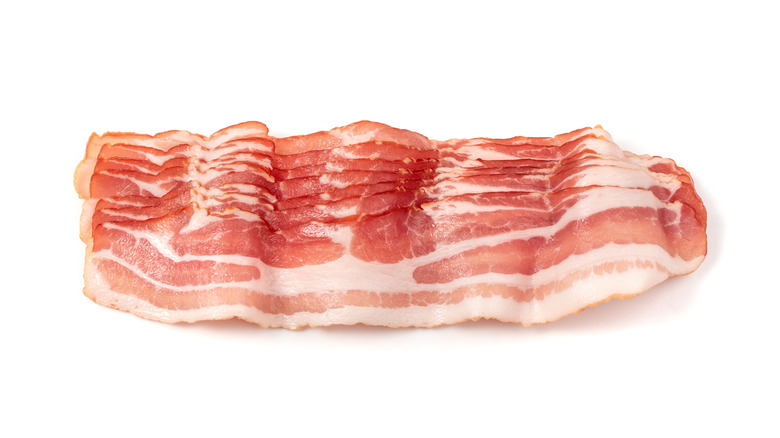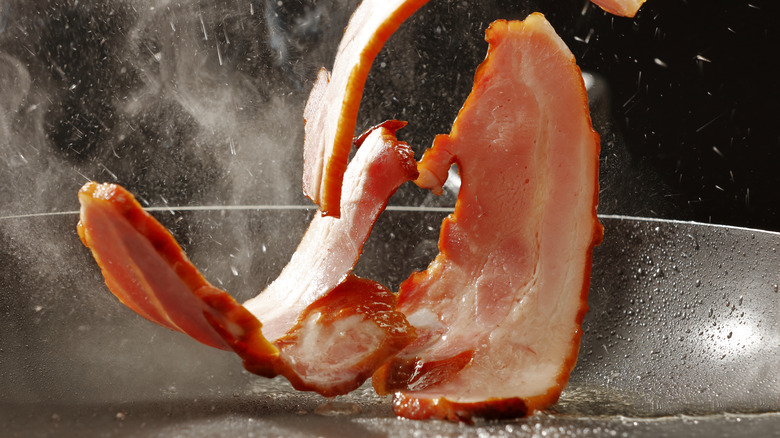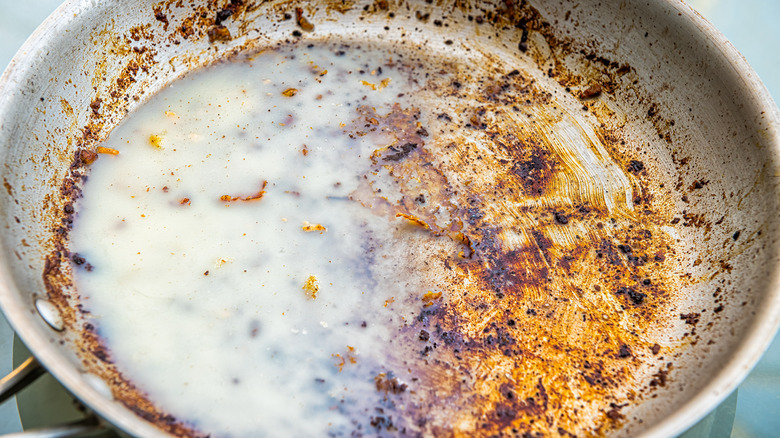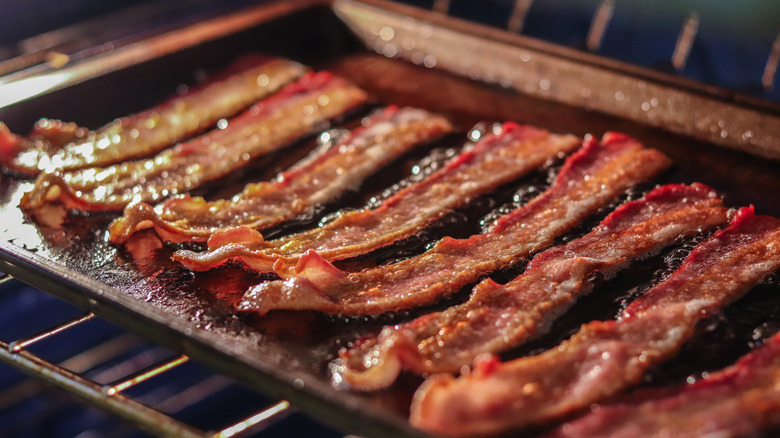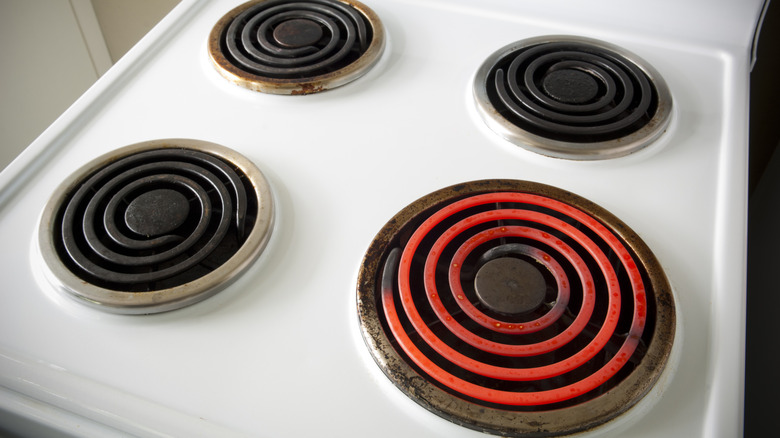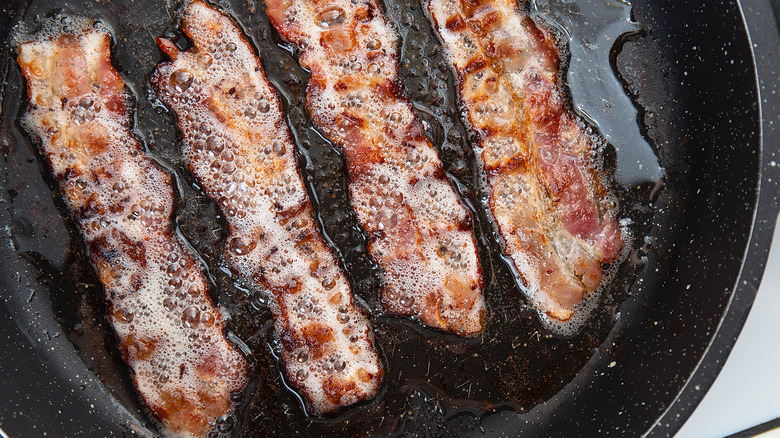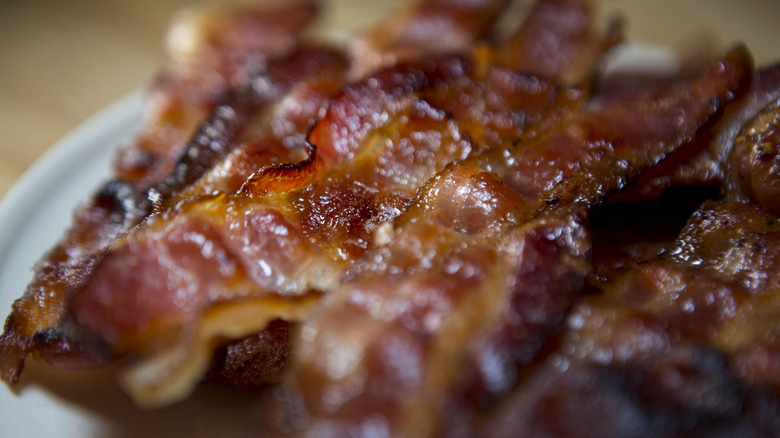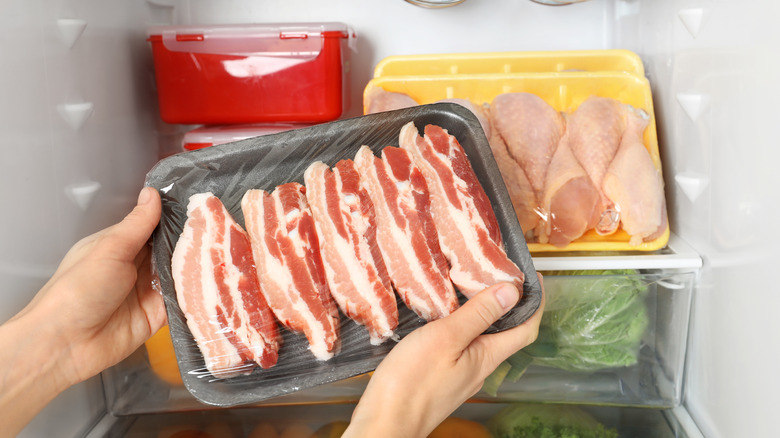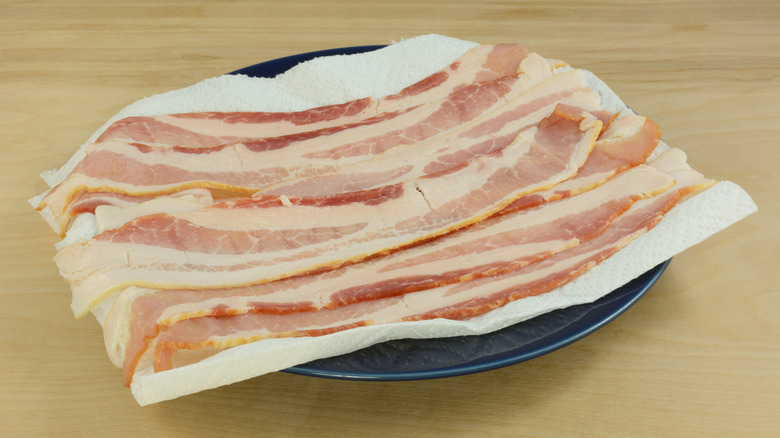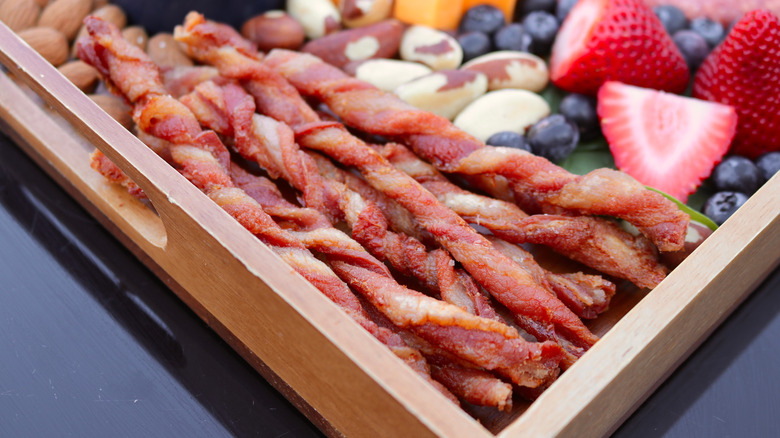Everyone Makes These Mistakes When Cooking Bacon
There is a lot of division in the world today, but if there is one thing that brings us all together, it's bacon. Okay, maybe not the vegans, but in the realm of meat-eaters, bacon is a lover, not a fighter. There is honestly nothing more satisfying than walking into a kitchen with the scent of bacon cooking. It's the universal symbol for the weekend, and it's unbelievably easy to cook up at home. The best thing about bacon is that it needs no other accompaniments to be delicious besides perhaps some toast and scrambled eggs.
But would you believe there are actually lots of ways you aren't maximizing the full potential of bacon when you're cooking it in your kitchen? We've compiled a list of the biggest mistakes everyone makes when cooking bacon and how to combat them, along with some bacon hacks that'll prepare you to utilize all that bacon offers.
Preheating the frying pan for bacon
Most recipes instruct you to heat a pan (usually with some type of fat or oil to grease it) on the designated heat setting, then add the food item. While you might assume you need to heat the pan before adding bacon, that's actually not the case. Experts insist the best bacon is cooked in a cold pan because slow and steady is the name of the game for an even cook. Letting the strips heat up along with the pan reduces the risk of burned bits of bacon and ensures the fatty parts don't turn too rubbery (via Southern Living).
Oh, and you also don't need to add any kind of cooking fat to the pan first. The bacon should render plenty of grease to keep it from sticking to the bottom of the pan. However, if you want to be extra cautious when using a cast iron pan, you can prevent bacon from sticking by simply adding a ½ tablespoon of oil. Furthermore, the cold pan method yields the most rendered fat (i.e., grease for cooking something else!) While non-stick skillets work, cast iron skillets are the golden child when it comes to the cold pan approach to cooking bacon.
Not saving the leftover bacon grease
If you've ever seen a jar of a waxy, nondescript-looking half solid/half liquid on your grandmother's kitchen counter, it might be her stash of bacon grease. While it may not look super appealing in appearance, the lard that results from the rendered drippings has a lot of uses in cooking and even outside the kitchen.
Not only can you use leftover bacon grease as a substitute for oil or butter in other recipes, but it can also be repurposed for multiple other projects including making candles, infusing bourbon with a bacon essence, and even sparking some flames for a fire. Also, don't make the mistake of pouring those valuable drippings down the kitchen sink — it's terrible for the pipes. Instead, be like Granny and store that grease in a canister or jar until you can bust it out next time you need real-deal bacon fat in a recipe.
Never utilizing the oven
When you dream (okay, fantasize) about cooking bacon, do you imagine yourself sweating over a hot stove, flipping the strips, and accepting that a layer of bacon grease splatter coating all of your cabinets is just par for the course? While that's one way to cook bacon, that's not the only way. It's wrong to assume bacon can only turn out tasty when cooked in a pan. Are you looking to make a big batch of bacon for a big crew? The oven is definitely the best method for larger portions of everyone's favorite breakfast meat.
All you need for some delicious, oven-baked bacon is a sheet pan, potentially some parchment paper, and a wire rack that fits in the pan over the parchment. This setup will allow the grease to drip onto the parchment, guaranteeing crispy bacon. You're missing out big time if you never explore the realm of cooking bacon in your trusty ol' oven.
Turning the stovetop heat up too high
While the sound of bacon sizzling seems like it results from a piping hot pan, bacon experts advise against using high heat when cooking. In reality, it's a big bacon no-no to crank up that stove burner to the highest heat possible. The ideal route to bacon that's crispy beyond your wildest dreams is a slow rendering process. If the meat cooks too fast, the fat won't render slowly enough, and you'll potentially get some rubbery patches on the strips. It's always best to stick to medium or medium-low heat when cooking bacon in a pan on the stove (via The Washington Post).
Even inpatient people should be able to handle lower heat with a longer cook time because, in the grand scheme, bacon strips still cook relatively quickly because they're so thin; even the thicker-cut slabs only take a few minutes per side.
Not flipping the bacon on the stovetop
Even the most novice chefs can quickly figure out how to cook bacon. The only items required are the bacon and a skillet (or sheet pan if you're cooking it in the oven). If you're going the stovetop route to get that bacon sizzling, it's a major misstep just to let it sit in the pan till it's cooked all the way through. The best-pan-fried bacon is turned and flipped during cooking, ideally by a pair of tongs, not just a fork. Tongs are excellent because they help you better grip the strips (although a fork will do in a pinch).
Make the flip when the bacon fat starts to turn translucent, then continue turning it periodically until your desired level of doneness (via Reddit). There is a full spectrum when it comes to bacon texture preferences (from soft to almost burnt to a crisp) but flipping the bacon ensures an even browning for all of them.
Not freezing the leftover cooked bacon
If you've got leftover cooked bacon — is everyone in the household okay? It seems like a rarity when there are strips of leftover cooked bacon but in those bizarre, Twilight Zone instances, use your freezer to preserve those strips, not the refrigerator. When you store cooked bacon in the freezer, it has a longer shelf life.
Wrap the individual strips of cooked bacon in paper towels, throw 'em in a ziplock bag, and keep them in your freezer for up to six weeks for ideal freshness. They won't take long (maybe a minute) to reheat in the pan and can also be heated up in the microwave if necessary. Technically you can keep leftover cooked bacon in the refrigerator, but it will need to be tossed after just five days. Extend the life of that bacon and don't make the mistake of putting it in the fridge — go freezer, or go back to the store to buy more bacon to cook.
Cooking bacon straight from the fridge
If you want to cook exceptionally flavorful bacon at home, there is a bit of an art form to it. While it may be tempting to pull out that pack of bacon the second you've got the pan ready and throw it on the stove, cooking bacon straight from the fridge is not recommended. Ideally, you should retrieve the bacon from the refrigerator and let it rest on the counter for about 15 to 20 minutes to come up to room temperature. Similar to why you shouldn't cook steak straight from the fridge, bacon also cooks better when it sits out for this suggested period before hitting the pan.
We know that waiting an extra 15 minutes from the fridge to the finished product isn't necessarily a complicated skill. Still, it requires patience from someone with a serious craving for bacon. So, cooking bacon (the right way) is somewhat of an art form for a patient cook.
Assuming you can't use the microwave
Microwaves aren't exactly kitchen royalty, and people definitely treat them as if they're merely a conduit for downing some popcorn or a sad frozen meal from a black plastic dish. So you might think you can't possibly make good bacon in a microwave, but this is a common misconception. Bacon cooked in the microwave is possible and perhaps way less messy than other methods.
Place your bacon between some sheets of paper towels for about 5 minutes in the microwave can be just as tasty and crispy as the kind you sizzle up in the oven. There is certainly way less grease to deal with, too, since the paper towels will absorb so much of the drippings. It's a personal preference at the end of the day. However, bacon can still be wonderful when cooked in the microwave, and it's a mistake to assume otherwise.
Skipping the water when cooking bacon
You've probably heard rumblings of adding water to a skillet when cooking bacon but dismissed it as an unnecessary step. However, we would argue that skipping this hack could be hindering your best-cooked bacon outcome.
Per Cooks Illustrated, the addition of water to the pan assists in maximizing the tenderness of the pork. This method helps to ensure that low and slow cooking temp that's ideal for making bacon. Additionally, the bacon is less prone to burning with this technique due to the magic of fat rendering while the water evaporates. Another bonus to putting water in the pan is less grease splatter popping off in your kitchen.
Adding just enough water to cover the bottom of the pan should do the trick (more than that will just take longer to burn off). Then wait for the water to evaporate before turning the heat up a bit and letting the bacon reach the ultimate level of browned crispiness.
Failing to try twisted bacon
Regularly cooking bacon at home and not jumping on the twisted bacon bandwagon? Big mistake. Well, we think it's a big mistake, at least. Instagram and TikTok are making twisted bacon a kitchen staple, potentially garnishing drinks and plates with all sorts of added flavoring. It's definitely a fun twist (we said it) on the classic bacon slice and perhaps a more snack-friendly, grab-and-go rendition of one of our favorite salty, low-carb delicacies.
Twisted bacon is made by twisting the raw bacon (which is pretty pliable in its raw state) and then popping the twists onto a sheet pan to cook in the oven. Abby Durlewanger of House of Keto fame suggests getting that entire pack of bacon on one sheet pan with the seasoning of your choice for the most efficient results. It's also worth noting that the tighter the twist, the crispier the bacon, per Today.
